In video games, a power-up is an object that adds temporary benefits or extra abilities to the player character as a game mechanic. This is in contrast to an item, which may or may not have a permanent benefit that can be used at any time chosen by the player. Although often collected directly through touch, power-ups can sometimes only be gained by collecting several related items, such as the floating letters of the word 'EXTEND' in Bubble Bobble. Well known examples of power-ups that have entered popular culture include the power pellets from Pac-Man and the Super Mushroom from Super Mario Bros., which ranked first in UGO Networks' Top 11 Video Game Powerups.
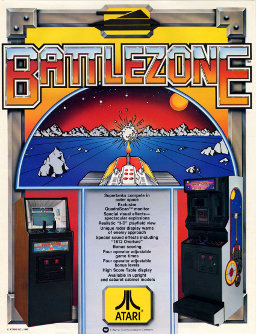
Battlezone is a first-person shooter tank combat game released for arcades in November 1980 by Atari, Inc. The player controls a tank which is attacked by other tanks and missiles. Using a small radar scanner along with the terrain window, the player can locate enemies and obstacles around them in the barren landscape. Its innovative use of 3D graphics made it a huge hit, with approximately 15,000 cabinets sold.
Spasim is a 32-player 3D networked space flight simulation game and first-person space shooter developed by Jim Bowery for the PLATO computer network and released in March 1974. The game features four teams of eight players, each controlling a planetary system, where each player controls a spaceship in 3D space in first-person view. Two versions of the game were released: in the first, gameplay is limited to flight and space combat, and in the second systems of resource management and strategy were added as players cooperate or compete to reach a distant planet with extensive resources while managing their own systems to prevent destructive revolts. Although Maze is believed to be the earliest 3D game and first-person shooter as it had shooting and multiplayer by fall 1973, Spasim has previously been considered along with it to be one of the "joint ancestors" of the first-person shooter genre, due to earlier uncertainty over Maze's development timeline.
An action game is a video game genre that emphasizes physical challenges, including hand–eye coordination and reaction time. The genre includes a large variety of sub-genres, such as fighting games, beat 'em ups, shooter games, rhythm games and platform games. Multiplayer online battle arena and some real-time strategy games are also considered action games.
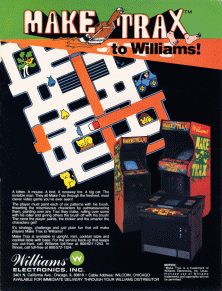
Make Trax, originally released in Japan as Crush Roller, is a 1981 maze game developed by Alpha Denshi and published as an arcade video game by Kural Samno Electric in Japan. It was licensed in Europe to Exidy, which released it under its original title Crush Roller, and in North America to Williams Electronics, who released it as Make Trax.
Exidy, Inc. was a developer and manufacturer of coin-operated electro-mechanical and video games which operated from 1973 to 1999. They manufactured many notable titles including Death Race (1976), Circus (1978), Star Fire (1978), Venture (1981), Mouse Trap (1981), Crossbow (1983), and Chiller (1986). They were also the creators of the Exidy Sorcerer (1978) home computer platform.

Star Wars is a first-person rail shooter designed by Mike Hally and released as an arcade video game in 1983 by Atari, Inc. It uses 3D color vector graphics to simulate the assault on the Death Star from the 1977 film Star Wars. There are three connected gameplay sequences: combat against TIE fighters in space, flying across the surface of the Death Star, and the final trench run. The sequence repeats with added complications and the Death Star regenerating for each. The player's X-Wing fighter has a shield which only protects against damage a certain number of times, then the next hit ends the game. Speech synthesis emulates actors from the film.
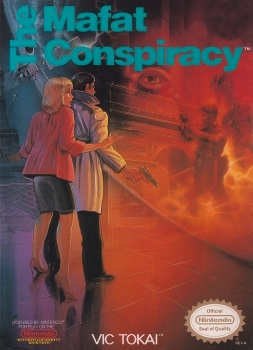
The Mafat Conspiracy is a Nintendo Entertainment System video game released in 1990. It is the sequel to Golgo 13: Top Secret Episode.

Chiller is a light gun arcade game released in 1986 by Exidy. An unlicensed port was released for the Nintendo Entertainment System in 1990 by American Game Cartridges in the US, and in Australia by HES, with the option of using either the standard controller or the NES Zapper.

Jazz Jackrabbit is a 1994 platform game developed and published by Epic MegaGames. It was released for MS-DOS-based computers. The game was re-released on GOG.com along with Jazz Jackrabbit 2 on November 30, 2017, with support for Windows, macOS, and Linux.

Targ is a maze shoot 'em up developed by Exidy and released as an arcade video game in 1980. It depicts vehicular combat in a future world. It was released in North America by Exidy in June 1980 and in Japan by Sega in July.
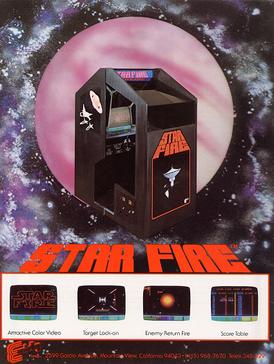
Star Fire is a first-person arcade coin-operated space combat video game created by Technical Magic for Midway-Bally and licensed for manufacture to Exidy in December 1978. It was distributed in Japan by Taito and Esco Trading in 1979. Designed by Caltech engineers Ted Michon, and David Rolfe and inspired by the movie Star Wars, the game is not based on a licensed property.

Space Dungeon is a multidirectional shooter released as an arcade video game by Taito in 1981. Designed and programmed by Rex Battenberg, it was available both as a conversion kit and full arcade cabinet. An Atari 5200 port was published in 1983.
Gradius is a series of shooter video games, introduced in 1985, developed and published by Konami for a variety of portable, console and arcade platforms. In many games in the series, the player controls a ship known as the Vic Viper.
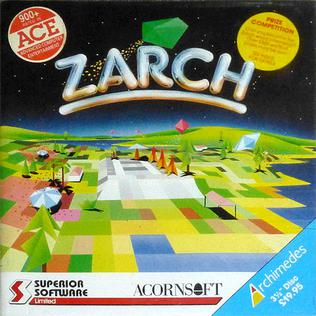
Zarch is a computer game developed by David Braben in 1987, for the release of the Acorn Archimedes computer. Zarch started off as a demo called Lander which was bundled with almost all releases of the Acorn Archimedes.

Journey is an arcade video game released by Bally Midway in 1983. Rock band Journey had enjoyed major success in the early 1980s, and Bally/Midway decided to ride this wave of popularity by creating an arcade game based on the group. Its release was intended to coincide with a US tour by the band.

Super Glove Ball is a game made by Rare in 1990 for the Nintendo Entertainment System, specifically designed to be played with the Power Glove controller. However, it can also be played with a standard NES controller. It was sold separately from the Power Glove.

Astro Chase is a multidirectional shooter written by Fernando Herrera for Atari 8-bit computers. It was published by First Star Software in 1982 as the company's first game. Parker Brothers licensed it, releasing cartridge versions for the Atari 8-bit family and Atari 5200 console in 1983 and a Commodore 64 version in 1984. Exidy licensed it for arcade use with its Max-A-Flex cabinet.
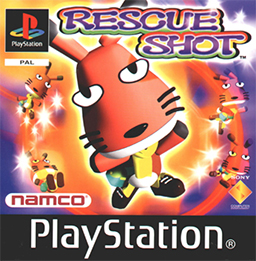
Rescue Shot is a PlayStation 3D light gun video game which was released in Japan and Europe in 2000. Compatible with the controller, GunCon and the PlayStation Mouse the title is non-violent and aimed at younger players, but more forgiving of poor accuracy than others in the genre. Players watch over the game's hero, Bo, as he absentmindedly makes his way through each location, dealing with enemies and manoeuvering him past dangers.

In video games, first-person is any graphical perspective rendered from the viewpoint of the player character, or from the inside of a device or vehicle controlled by the player character. It is one of two perspectives used in the vast majority of video games, with the other being third-person, the graphical perspective from outside of any character ; some games such as interactive fiction do not belong to either format.















